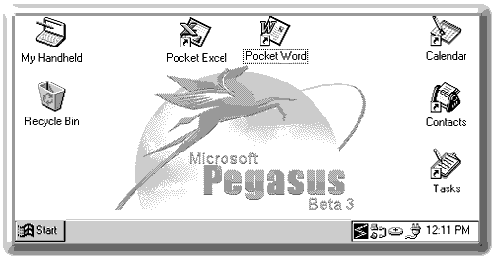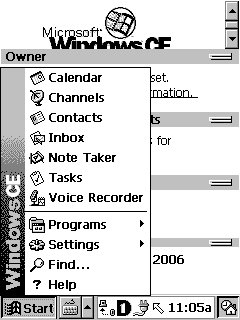This article is more than 1 year old
Microsoft's Cloud UI brings Windows full circle
You don't want a taskbar? Fine, we'll take it out. OK, we'll put it back again
Microsoft is said to be developing a cross-platform shell to bring the desktop Windows antiques to non-PC devices of different shapes and sizes.
According to rumours whispered into the ear of Windows Central, the project is called the "Composable Shell", or CSHELL. Or if this is a mishearing – quite plausible – a Compostable Shell. "Cloud Shell" is another rumour, possibly unrelated.
The blog suggests that CSHELL brings a scalable Windows desktop, with popup start menu and taskbar, to appropriate devices. We don't have pictures. Yet.
If CSHELL is more a kite-flying exercise, it means Microsoft has taken a decade to turn full circle.
From 1996 to 2009, Microsoft tried to scale down full-fat Windows UI to squeeze into a mobile device. The first attempt, a now forgotten monochrome Psion clone that flew under the code name Pegasus, and eventually launched as Windows CE 1.0.
This UI featured a popup Start menu and taskbar, desktop icons, and even a system tray. Window furniture included 3D relief close and minimise buttons. In short, it tried to replicate a Windows PC desktop in every way, except in a minimal amount of screen space. WinCE 1.0 specified a 480x240 pixel display with four grayscales. Windows overlapped, but with the all that UI chrome, there wasn't much room either inside or outside the window. Microsoft reckoned it sold a million.

Microsoft's Palm clone variant of Windows CE ("PocketPC") also retained the blocky UI furniture, and was the first mobile platform to register a success, riding on the pent-up demand for in-car satellite navigation.

Yes, of course you want a start menu and taskbar on your tiny Palm-sized handheld.
Microsoft retained this design approach – scaling down the desktop Windows – until early 2010. That's when it announced Windows Mobile was being dumped in favour of a ground-up redesign based on its Zune music player.
This took into account the runaway success of Apple's iPhone, which proved that it was possible to create a sophisticated platform without cloning the clutter of a desktop computer. Even Steve Jobs expressed his admiration of the WP7 UI. As well he might, for it's the mobile UI that copies as little as possible from iPhone, while introducing more original elements and ideas.
Microsoft then forced the mobile interface onto its PC users – to their great chagrin. The Windows 8 shell, designed for touchscreen tablets, launched in 2012 with no concession to the desktop PC users had been used to at all. Microsoft finally abandoned this misadventure with Windows 10 in 2015.
Users are so familiar with overlapping windows, a taskbar and popup Start menu, it seems Windows isn't Windows without them. ®
